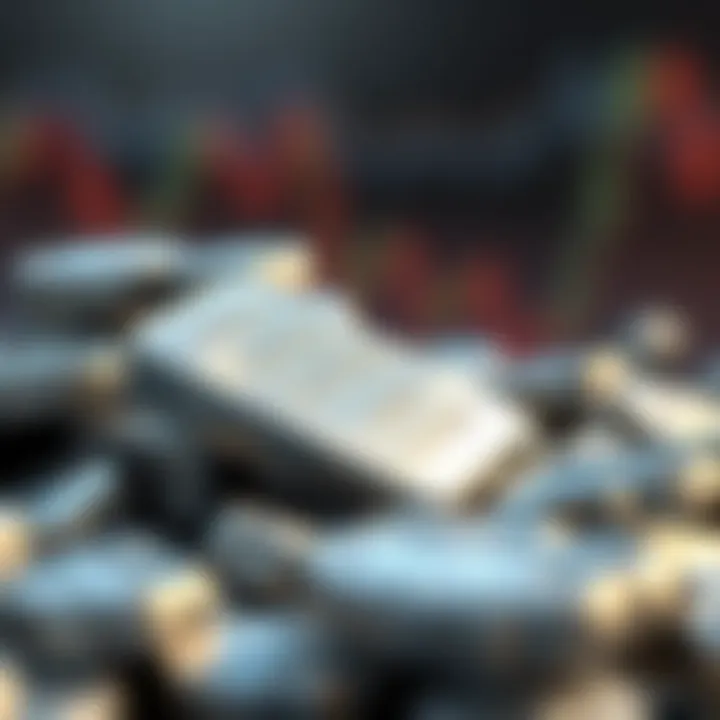Exploring the Future of Silver Investment Strategies


Intro
The current financial landscape often finds itself in a state of flux, compelling investors to continuously seek new avenues for growth and stability. Among the various options available, silver investment stands out—not merely as a relic of times past but as a viable contender in the portfolio of savvy investors. This precious metal carries historical weight that goes back thousands of years, and its significance in today’s economic climate cannot be overstated.
With evolving market dynamics and the persistent allure of diversification, understanding the future of silver as an investment opportunity is crucial for anyone serious about wealth accumulation.
Before diving into strategies and considerations, it's essential to lay the groundwork with some investment terms that will come into play throughout this discussion. With so much to unpack, let’s break it down in a manner that builds toward a rich understanding of what silver investment entails.
Understanding Silver as an Investment
Investing in silver represents a multifaceted approach to building wealth, one that blends historical significance with modern market dynamics. For savvy investors, silver isn't just another precious metal; it's a long-standing player in the economic arena. Understanding its nuances can provide critical insights into potential investments. Silver has had myriad uses over centuries—serving both as an industrial metal and a store of value—making it a compelling proposition for those looking to diversify their portfolios.
Yet, silver investment comes with its fair share of considerations. Unlike gold, silver often reflects industrial demand, influenced heavily by economic conditions and technological advancements. This volatility can present both opportunities and risks. Investors must weigh the historical context of silver against current market positions to fully grasp its potential.
Key Elements to Consider:
- Historical Significance: Silver has been valued throughout history, often serving as a currency or barter tool.
- Market Sensitivity: Silver prices react sensitively to changes in global demand and supply.
- Diverse Applications: From jewelry to electronics, its varied uses support its market resilience.
- Investment Strategies: Different methods, such as ETFs and physical ownership, each present unique advantages.
Investors and financial advisors should take advantage of these factors to tailor their strategies effectively. Understanding silver as an investment enables better navigation through market shifts while aligning with individual financial goals.
Historical Context of Silver Investment
Silver’s journey as a valuable asset begins long before modern markets emerged. In various cultures, it has represented wealth and status. Ancient civilizations across the globe utilized silver, either in trade or for ornamental purposes. Notably, the use of silver coins can be traced back to the Lydians around 600 BC. This historical significance still resonates today, reinforcing silver's appeal as a long-term savings asset.
Over centuries, silver maintained its place alongside gold, albeit with different functions. During economic upheaval, many turn to silver as a more accessible alternative to gold. This trend can be observed during crises, where silver often strikes a balance between affordability and investment security. Additionally, technological advancements have led to increased industrial demand, particularly in fields such as solar energy and electronics. As such, investors must consider not just historical value, but present-day relevance.
Current Market Position of Silver
As of now, silver occupies a unique position in the market, reflective of both its intrinsic and economic value. Following the COVID-19 pandemic, silver prices witnessed significant fluctuations, driven by a surge in industrial demand and changing investment sentiments. According to analysts, silver has transitioned into a dual role: it functions as a hedge against inflation while still catering to industrial needs.
The current market dynamics suggest that silver is not destined to remain stagnant; its pricing tends to mirror economic conditions closely. Reports from the London Bullion Market Association indicate that growth in electric vehicle production, for example, has led to a steady increase in silver utilization. This confluence of demand factors signals a promising outlook for silver as an investment.
Market Insights:
- The price of silver is currently influenced by global industrial demand, especially in technology sectors.
- Economic indicators, such as inflation rates and interest changes, will continue to shape its value.
- Awareness of geopolitical developments is crucial, as they can directly impact investment patterns in silver.
For investors, grasping the current market position is essential for making informed decisions. By coupling historical context with present-day analytics, one can carve out a path in the silver investment landscape that seems as promising as ever.
The Economic Factors Influencing Silver Prices
Understanding the economic factors influencing silver prices is fundamental for investors seeking to navigate the complexities of the precious metal market. Silver, often referred to as a safe haven during turbulent economic times, does not exist in a vacuum. Instead, its value is swayed by a plethora of elements ranging from global economic health to specific market dynamics. Investors need to grasp these factors intimately to make informed decisions and strategize effectively.
Global Economic Indicators
Global economic indicators serve as the backbone for gauging the overall health of economies and, consequently, the silver market. Key metrics such as Gross Domestic Product (GDP), unemployment rates, and manufacturing outputs can significantly affect investor sentiment.
For instance, a rising GDP typically signals robust economic health, leading to increased industrial demand for silver, particularly in electronics and solar energy sectors. Conversely, if economic indicators point toward a recession, you'll see a surge in demand for silver as a safe haven asset. Investors flock to silver, driving its price up as they seek security against financial uncertainty.
In addition, inflation rates play a crucial role. When inflation rises, the value of currency diminishes, and commodities like silver tend to increase in value due to their intrinsic worth. Therefore, an astute investor should keep a keen eye on inflationary trends and related indicators.
Supply and Demand Dynamics
The age-old axiom of supply and demand rings truer than ever in the realm of silver investment. The delicate balance—or imbalance—between how much silver is being mined and the levels of demand from various sectors can create price fluctuations.


Supply Elements:
- Mining Production: Major silver producers like Mexico and Peru influence the overall supply chain. A natural disaster or a drop in mining efficiency can lead to a scarcity, pushing prices upwards.
- Recycling: Unlike gold, a substantial portion of silver comes from recycling processes. A higher recycling rate can stabilize supply but could also lead to lower prices if demand does not keep pace.
Demand Factors:
- Industrial Uses: Silver has a plethora of applications. From solar panels to medical imaging, industries continuously draw upon silver. An uptick in manufacturing activity can thus lead to higher prices.
- Investor Demand: Investment demand, driven largely by ETFs (Exchange-Traded Funds) and bullion purchases, has surged recently. This trend can send silver prices skyrocketing, especially during economic downturns.
Ultimately, keeping a finger on the pulse of supply and demand forces gives silver investors a distinct advantage.
Geopolitical Influences on Silver
Geopolitical events can turn the tides for silver prices in a heartbeat. Tensions between countries or significant policy changes can affect market dynamics significantly. Various elements contribute to this, and understanding them can provide a competitive edge in investment decisions.
- War and Conflict: Historical evidence shows that conflicts often lead investors to seek stability in precious metals, including silver. When unrest arises, silver prices frequently climb as traders see it as a hedge against instability.
- Trade Relations: Tariffs, trade wars, or sanctions can disrupt the supply chain of silver. For example, tensions between the U.S. and China could lead to significant volatility in silver prices, depending on how these relations evolve.
"Understanding the interplay of geopolitical tensions is crucial for any serious silver investor—these factors can overturn market predictions overnight."
By recognizing these geopolitical factors, investors can be better poised to anticipate price fluctuations in silver, optimizing their investment strategies accordingly. As we advance, grasping these economic factors will empower investors to make well-informed decisions that align with their financial goals.
Silver vs. Other Precious Metals
The discussion around silver as a valuable investment often brings its relationship to other precious metals into focus. For investors looking towards diversification, understanding how silver stacks up in comparison, particularly to gold, is crucial. Silver not only plays a vital role in industry but also carries with it a weighty historical significance akin to that of gold. This makes it a noteworthy consideration for those aiming to build a well-rounded investment portfolio. The insights gained from comparing silver to other precious metals can illuminate the unique traits and potential advantages of investing in silver.
Comparative Analysis with Gold
Gold, often regarded as the king of precious metals, has been the go-to choice for many investors seeking stability during economic downturns. However, silver shouldn't be overlooked. Here’s why:
- Affordability and Accessibility: Silver is significantly cheaper than gold, making it more accessible for entry-level investors. Where one ounce of gold might cost over a thousand dollars, silver could be bought for a fraction of that. This allows investors to purchase more units, which can add up in the long run.
- Industrial Demand: Unlike gold, which primarily serves as a store of value, silver has a robust industrial role. From electronics to solar panels, silver is in high demand in various sectors. This can lead to price surges during industrial booms.
- Volatility Potential: Silver tends to be more volatile than gold—this dual-edged sword can benefit active traders. For those with a keen eye and risk tolerance, the price fluctuations can be an opportunity rather than a disadvantage.
- Historical Context: Over the decades, silver has been traditionally viewed as a hedge against inflation and currency devaluation. In volatile times, many turn to both gold and silver; however, silver's lower intrinsic value can sometimes result in it being overlooked during these pivotal moments.
To summarize, while gold might offer a stronger sense of security, silver brings unique possibilities, particularly in terms of accessibility and industrial applications. An investor’s choice between the two should take into account their individual circumstances and investment strategy.
Other Alternatives in Precious Metals
Venturing beyond silver and gold, the precious metals arena includes platinum and palladium, each with its own distinctive traits and investment considerations.
- Platinum: Known for its rarity and high tolerance to wear, platinum is not typically seen in the same light as silver. Its price often mirrors industrial demand, especially in the automotive sector for catalytic converters. Investors in platinum might find it appealing for its potential to maintain value during economic shifts.
- Palladium: Rising in popularity, palladium has emerged as a major player primarily due to its necessity in the manufacturing of vehicle emissions systems. As environmental standards tighten, palladium's demand could continue to rise, setting it apart in terms of growth potential compared to silver.
- Rhodium: Although not as commonly traded, rhodium is making headlines due to its significant price dynamics—often offering a more aggressive investment path. Investors should be aware, however, that its market can be extremely volatile and might not suit everyone.
Ultimately, diversifying within the precious metals category might help in managing risk and capitalizing on different market conditions. Whether it is silver, gold, or alternative metals like platinum and palladium, each comes with its own set of opportunities and should be evaluated thoughtfully as part of a broader investment strategy.
"Understanding the individual characteristics of each metal can arm an investor with the ability to navigate the often unpredictable waters of the precious metals market."
Investment Methods in Silver
When diving into the world of silver investment, understanding the various methods available is essential. This section explores how different investment avenues can suit diverse objectives, ranging from individuals seeking tangible assets to those preferring more liquid options. With the silver market's unique characteristics, each method carries its own set of benefits and drawbacks that can shape an investor's approach. For potential investors and financial advisers, grasping these methods is vital for developing a well-rounded strategy.
Physical Silver Ownership
Silver Bullion Bars
Silver bullion bars are a popular choice among investors looking to acquire silver in its purest form. The key characteristic of these bars is their high silver purity, typically around 99.9%. This makes them an attractive option for those who prioritize quality in their investments. One of the benefits of investing in silver bullion bars is their ease of storage. They often come in standardized weights, which simplifies both the buying and selling process.
A unique feature of bullion bars is their liquidity; they can be easily sold or traded for cash, especially in established markets. However, potential investors should also consider the disadvantage of needing secure storage solutions, as physical silver can be vulnerable to theft.
Investing in physical silver means putting your trust in something tangible, rather than paper promises.


Silver Coins
Silver coins offer a slightly different angle on silver ownership, often capturing both numismatic and investment interest. The key aspect of silver coins is that they often come with a face value, making them legal tender in many jurisdictions, which can add a layer of credibility. Coins like the American Silver Eagle or the Canadian Silver Maple Leaf are popular choices because of their recognized purity and backing by national governments.
Silver coins can be seen as a beneficial investment mainly due to their appeal to collectors; many coins hold value above their silver content, thanks to rarity and design. However, one drawback is the potential premium that collectors might pay for coins compared to their bullion bar counterparts.
When purchasing silver coins, it’s essential to bear in mind both the market conditions and the particular coins’ value in relation to their silver weight.
Silver ETFs and Mutual Funds
Investing in silver exchange-traded funds (ETFs) and mutual funds can be an effective method for those who prefer not to hold physical silver. ETFs provide a straightforward way to gain exposure to silver prices without the hassle of storage and security issues. Investors buy shares of the fund, which represent an underlying amount of silver stored in vaults.
With silver mutual funds, investors contribute to a pool that generally comprises various silver assets, including mining companies. This diversified approach can mitigate some risks associated with direct silver investment. Nonetheless, these options come with management fees and may not fully replicate the movements of physical silver price due to how the funds are structured.
Mining Stocks and Silver Futures
Investing in mining stocks can offer a different type of exposure to silver investment. Instead of dealing directly with silver, investors buy shares in companies engaged in silver extraction. The volatility of mining stocks can be significant, influenced by multiple factors such as operational efficiency, market trends, and geopolitical risks. This choice can be beneficial for those looking to capitalize on market fluctuations but it can also introduce additional uncertainties.
Another avenue is silver futures, where contracts are made to buy or sell silver at predetermined prices on specific future dates. This method can yield high returns if leveraged correctly; however, it also carries a higher risk, as investors can lose much more than their initial investment if the market goes against them.
Risk Considerations in Silver Investment
When diving into the world of silver investment, it is crucial to grasp the various risks involved. Any savvy investor knows that with potential profits come inherent threats. This section aims to shed light on significant risk factors that can impact silver investments, ranging from market fluctuations to liquidity challenges and counterparty issues. Understanding these aspects can help investors strategize and navigate the treacherous waters of the silver market more effectively.
Market Volatility
Silver prices can swing like a pendulum, making them vulnerable to a variety of influences that create turbulence in the market. Economic shifts, geopolitical events, and changes in investor sentiment can all play a role in shifting prices dramatically. For instance, during periods of economic uncertainty, the demand for silver may rise as investors flock to safe havens. Conversely, if the economy shows signs of stability and growth, silver may take a hit as investors redirect their funds.
"Volatility is not the enemy of the investor, but a tool, if understood properly."
Investors need to keep a close eye on trends and indicators. Staying informed about global events, inflation rates, and currency strength will help in predicting silver's market movements. Developing a strategy that accounts for potential price swings can be crucial. Some might find it beneficial to use stop-loss orders to mitigate losses, while others may choose to engage in options trading to hedge against volatility risks.
Liquidity Risks
Liquidity refers to how easily an asset can be converted into cash without negatively impacting its market price. In silver investment, liquidity can be a double-edged sword. On one hand, physical silver can face difficulty in selling quickly in the higher-end markets without a considerable price drop. On the other hand, silver ETFs allow for quicker transactions but may suffer from limited trading volumes.
It’s essential to assess the liquidity of your chosen investment method. When investing in physical silver, consider items like coins or bars that have a recognised market demand. Those who lean toward silver stocks or ETFs should investigate the average volumes traded. A low liquidity can pose a risk if an investor needs to sell in a hurry.
Counterparty Risks in Trading Platforms
Engaging with online trading platforms can introduce another layer of risks for silver investors. The reliability and trustworthiness of the exchange or broker is paramount. Counterparty risk arises when the other party involved in a transaction fails to meet their obligations. This is particularly important for investors dealing with futures contracts or ETFs, where there’s a third party managing the assets.
To minimize these risks, investors should conduct thorough research on their chosen platforms. Look into their compliance with regulations, fees, and user reviews. Avoid platforms with a shaky reputation, as these can lead to significant financial loss. It’s prudent to ensure that any brokerage is insured and regulated by recognised authorities, providing an added layer of security to your investments.
Understanding these risks and developing strategies to manage them is fundamental in securing your investments in silver. Investors who prioritize risk management are likely to navigate the silver investment landscape with greater confidence and ultimately achieve their financial goals.
Future Outlook for Silver Investment
Predicted Market Trends
The silver market is often described as a rollercoaster ride, reflecting the dynamic interplay of various economic factors. Here are some predicted trends that could play a pivotal role in shaping its future:
- Increasing Industrial Demand: Silver’s unique properties make it crucial in various industrial applications, especially in electronics and renewable energy solutions. As global green initiatives ramp up, demand for silver in solar panels and electric vehicle production is likely to increase.
- Inflation Hedge: With inflation appearing to be a persistent threat in many economies, silver's potential to serve as a hedge against currency devaluation might attract new investors. Historically, precious metals have been seen as a safeguard during inflationary periods.
- Fluctuating Supply Chain: Supply chain disruptions, whether from geopolitical tensions or trade policies, can have immediate effects on silver prices. As seen in 2020 and onward, any hiccup in global mining operations or trade routes can cause sharp price movements.
"Investors who adapt to changing market conditions can unlock new avenues for growth within the silver landscape."


- Growing Interest from Institutional Investors: More institutional investors are turning to silver as part of their portfolios, driving demand up. This shift could stabilize the market, but it may also create greater volatility in the short term.
By monitoring these trends, investors can craft a strategy that capitalizes on both opportunities and potential challenges in the silver market.
Technological Advancements and Their Impact
Technology is a double-edged sword in the silver investment domain. While it can bring about efficiencies and innovations, it can also lead to unexpected shifts in market dynamics. Here’s a look at how technology could influence the landscape for silver:
- Enhanced Mining Techniques: Advances in extraction methods, like biotechnology and automation, may lead to more efficient and cost-effective mining practices. This could potentially lower production costs and affect supply levels positively.
- Digital Silver: The rise of digital currencies and blockchain technology has paved the way for the emergence of 'digital silver' options. Tokenization of silver assets could make investing more accessible and liquid, attracting a new generation of investors.
- Investment Platforms and Data Analytics: The increasing sophistication of investment platforms provides real-time analytics and data, allowing investors to make more informed decisions. Enhanced predictive algorithms could offer insights into price movements, making silver investment more strategic.
For more in-depth information on the subject, you can explore valuable resources on silver trends at Britannica and Investopedia.
Regularly revisiting your strategies based on current market assessments will keep you ahead in the game.
Building a Silver Portfolio
When it comes to investing, building a solid and diversified portfolio is akin to preparing a hearty meal; each ingredient must complement the others to create balance and flavor. In the realm of silver investment, this concept is no different. A well-structured silver portfolio not only mitigates risks but also maximizes potential returns over the long haul. The beauty of silver lies in its versatility; whether through physical assets or financial instruments, the possibilities are ample. Understanding how to effectively weave silver into your overall investment strategy is essential.
Diversification Strategies
Diversification is one of the keystones of investment wisdom. Simply put, don’t put all your eggs in one basket. When handling silver investments, consider these strategies to safeguard your capital:
- Mixing Asset Classes: Invest in a combination of physical silver and silver-backed securities. Physical assets can include bullion bars and coins, while securities encompass stocks of mining companies or ETFs. This blend can create a more resilient portfolio.
- Geographic Diversification: Silver prices can be influenced by various global factors. Investing in silver from different regions can protect against localized economic downturns. For instance, silver mines in Canada may operate independently of those in Peru, providing a safeguard against regional instability.
- Timing Your Investments: Monitoring market cycles is crucial. Accumulating silver during price dips or economic uncertainty can lead to favorable average costs and higher returns over time.
"A diverse portfolio is like a well-stocked pantry; it prepares you for any culinary adventure that may arise in financial markets."
Adjusting your strategy according to market trends will help maintain a robust allocation. Remember, flexibility is key.
Aligning Investment Goals with Silver Assets
Aligning your investment goals with your silver assets is akin to ensuring your shoes fit when you're gearing up for a long trip. If the fit isn't right, you might find yourself uncomfortable along the way. Here are key considerations:
- Investment Horizon: Are you looking for short-term gains or willing to ride the waves for long-term appreciation? Silver can behave differently based on your time frame. Short-term investors may focus on trading futures, while long-term investors often find comfort in physical silver ownership.
- Risk Appetite: Understanding your tolerance for risk is crucial. If you're more risk-averse, a portfolio focused on physical silver assets may be more suitable; conversely, those who are more daring might delve into mining stocks or futures trading.
- Financial Goals: Define your goals clearly. Are you seeking wealth preservation, speculation, or perhaps a combination of both? Silver’s role in your portfolio should directly reflect these ambitions, guiding your investment decisions and timing.
Bringing it all together requires continuous reflection and adjustment. As the silver market evolves, so should your strategy, ensuring you stay aligned with your goals. For further reading on silver's future and other financial insights, you may visit sources such as Investopedia or Kitco.
Culmination
In the intricate world of silver investment, arriving at a well-rounded conclusion becomes essential. This section serves as a summation of the critical elements discussed throughout the article, shedding light on the intricacies of investing in this precious metal while also considering the future outlook. It encapsulates the importance of adapting to changing market dynamics and understanding how various factors interplay to influence silver prices.
Building a robust investment strategy is essential. Investors must weigh the benefits and drawbacks of silver as part of their portfolios. Not only does it offer diversification, but its unique qualities can provide a hedge against economic uncertainties. As the discussion has illustrated, geopolitical events, technological advancements, and shifts in supply and demand dynamics play a significant role in shaping the market.
Moreover, investors need to approach silver with a keen understanding of risk considerations, recognizing the volatility that can arise in such a market. A well-thought-out strategy can diminish potential pitfalls and align investments with individual goals.
"In the world of investment, knowledge is the compass that guides you through uncertain waters."
Summing it all up, silver investment presents a compelling opportunity for those willing to conduct thorough research and navigate carefully through the complexities of the financial landscape. The key here is to remain adaptable, continually educate oneself, and align silver assets with broader investment objectives.
Key Takeaways on Silver Investment
- Historical Significance: Silver’s long-standing role as a store of value has positioned it as a viable investment option.
- Market Positioning: Understanding current trends is crucial. With silver often influenced by market fluctuations, staying informed about price movements can assist in making wiser investment decisions.
- Economic Indicators: Monitoring global economic conditions can offer insight into silver’s performance. Variables like inflation rates and currency valuations typically have strong correlations with silver prices.
- Investment Methods: Various avenues for silver investment exist, from physical ownership to trading through ETFs. Each method has its unique risks and rewards.
- Portfolio Strategy: Integrating silver into a broader investment portfolio can yield benefits in diversification and risk management.
Final Thoughts
Looking forward, silver holds a distinct place in the investment arena. The ongoing technological advancements and the call for sustainability are likely to spur new demand for silver in sectors like renewable energy and electronics. This narrative reinforces the metal’s relevance in future markets.
For investors contemplating their next moves, the journey of silver investment isn’t merely an exploration of monetary value; it’s about understanding the underlying factors that drive its worth. It’s important to keep a finger on the pulse of market trends while preparing for both opportunities and risks that lay ahead.
Silver remains a fascinating and potentially rewarding investment, offering those who choose to explore it not just a hedge against economic unpredictability, but also a stake in future technological advancements. In this realm of investment, the learner remains the master, making informed decisions that guide their path in the ever-evolving landscape of silver.
Explore more about silver investment at Investopedia or read articles in The Wall Street Journal for the latest trends.















